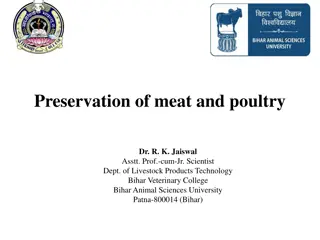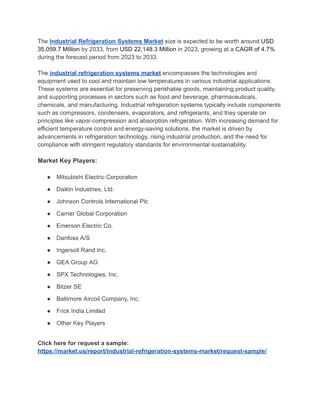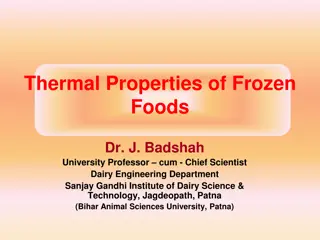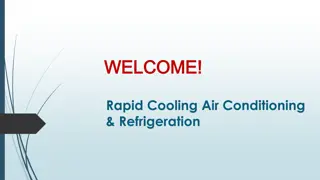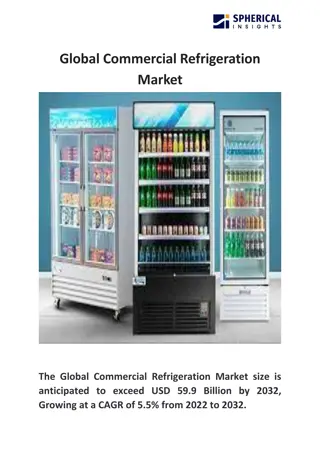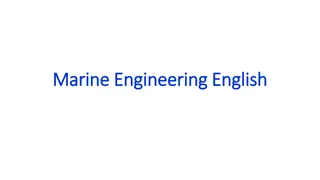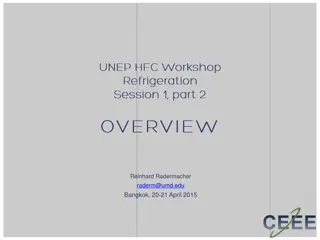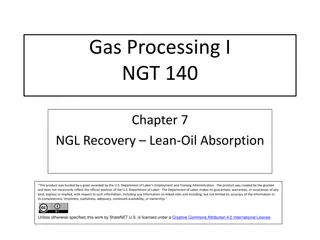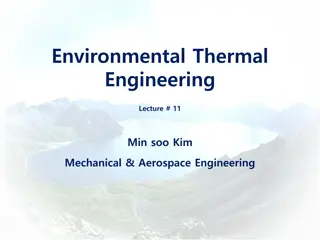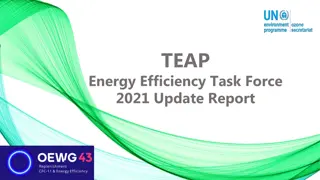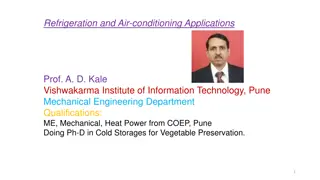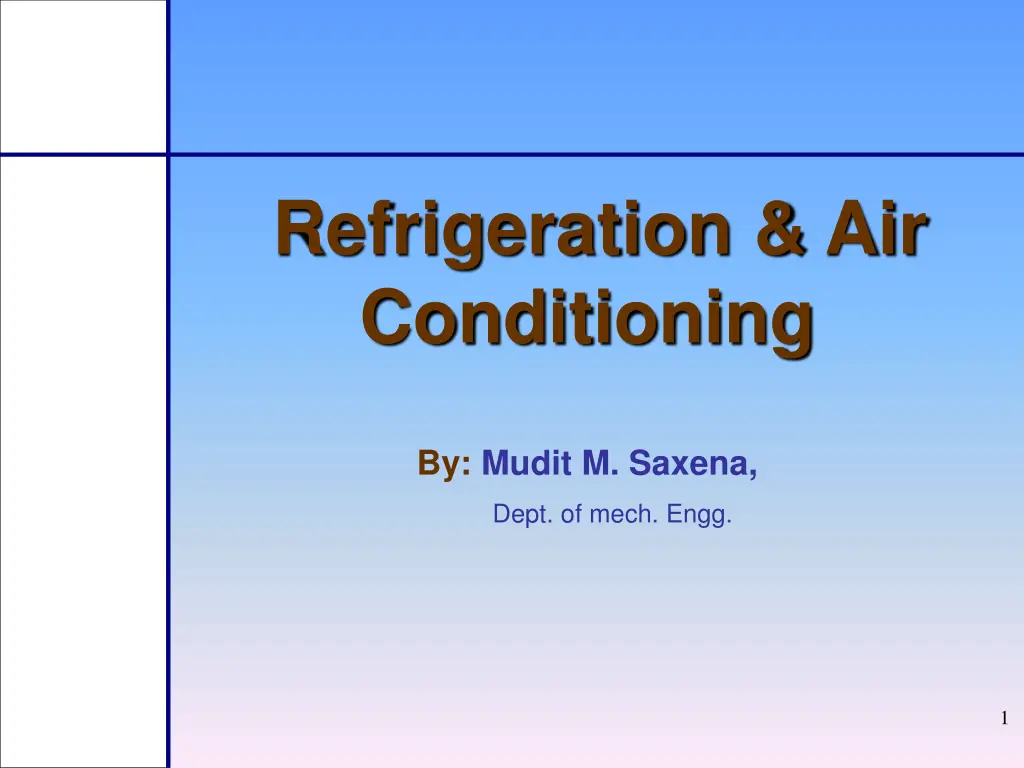
Understanding Refrigeration and Air Conditioning Systems
Explore the fundamentals of refrigeration and air conditioning systems, including how they work, the importance of Coefficient of Performance (CoP), units of refrigeration, Ton of Refrigeration (TR), AC system options, types of refrigeration systems, and more. Gain insights into the principles and technologies behind cooling systems.
Download Presentation

Please find below an Image/Link to download the presentation.
The content on the website is provided AS IS for your information and personal use only. It may not be sold, licensed, or shared on other websites without obtaining consent from the author. If you encounter any issues during the download, it is possible that the publisher has removed the file from their server.
You are allowed to download the files provided on this website for personal or commercial use, subject to the condition that they are used lawfully. All files are the property of their respective owners.
The content on the website is provided AS IS for your information and personal use only. It may not be sold, licensed, or shared on other websites without obtaining consent from the author.
E N D
Presentation Transcript
Refrigeration & Air Conditioning By: Mudit M. Saxena, Dept. of mech. Engg. 1
Introduction How does it work? High Temperature Reservoir Heat Rejected Work Input R Heat Absorbed Low Temperature Reservoir By: Mudit M. Saxena, Dept. of Mech. Engg.
Coefficient of Performance (CoP) Coefficient of Performance (CoP) is very important in determining a system's overall efficiency. It is defined as refrigeration capacity in kW divided by the energy input in kW. While CoP is a very simple measure, like the kW. 3 By: Mudit M. Saxena, Dept. of Mech. Engg.
Units of refrigeration The units of refrigeration are always a unit of power. Domestic and commercial refrigerators may be rated in kJ/s, or Btu/h of cooling. For commercial and industrial refrigeration systems most of the world uses the kilowatt (kW) as the basic unit refrigeration. 4 By: Mudit M. Saxena, Dept. of Mech. Engg.
Ton of Refrigeration (TR). One Ton of Refrigeration was defined as the energy removal rate that will freeze one ton of water at 0 C (32 F) in one day(24 Hrs). One Ton s value as historically defined is approximately 11,958 BTU/hr (3.505 kW) has been redefined to be exactly 12,000 BTU/hr (3.517 kW). 5 By: Mudit M. Saxena, Dept. of Mech. Engg.
Introduction AC Systems AC options / combinations: Air Conditioning (for comfort / machine) Split air conditioners Fan coil units in a larger system Air handling units in a larger system 6 By: Mudit M. Saxena, Dept. of Mech. Engg.
Types of Refrigeration Refrigeration systems Vapour Compression Refrigeration (VCR): uses mechanical energy Vapour Absorption Refrigeration (VAR): uses thermal energy 7 By: Mudit M. Saxena, Dept. of Mech. Engg.
Type of Refrigeration Vapour Compression Refrigeration Highly compressed fluids tend to get colder when allowed to expand If pressure high enough Compressed air hotter than source of cooling Expanded gas cooler than desired cold temperature 8 By: Mudit M. Saxena, Dept. of Mech. Engg.
VAPOUR COMPRESSION REFRIGERATION CYCLE ( T-S diagram ) 1-2 Isentropic compression 2-3 Constant pressure heat rejection in the condenser 3-4 Throttling in an expansion valve 4-1 Constant pressure heat addition in the evaporator 9 By: Mudit M. Saxena, Dept. of Mech. Engg.
VAPOUR COMPRESSION REFRIGERATION CYCLE ( p-h diagram ) 1-2 Isentropic compression 2-3 Constant pressure heat rejection in the condenser 3-4 Throttling in an expansion valve 4-1 Constant pressure heat addition in the evaporator By: Mudit M. Saxena, Dept. of Mech. Engg. 10
Typical Refrigeration Cycle By: Mudit M. Saxena, Dept. of Mech. Engg. 11
Components Refrigerant Evaporator/Chiller Compressor Condenser Receiver Thermostatic expansion valve (TXV) 12 By: Mudit M. Saxena, Dept. of Mech. Engg.
Vapour Compression Refrigeration Two advantages Lot of heat can be removed (lot of thermal energy to change liquid to vapour) Heat transfer rate remains high (temperature of working fluid much lower than what is being cooled) 13 By: Mudit M. Saxena, Dept. of Mech. Engg.
Vapour Compression Refrigeration Refrigeration cycle 3 Condenser High Pressure Side 4 Expansion Device Compressor 2 Low Pressure Side 1 Evaporator 14 By: Mudit M. Saxena, Dept. of Mech. Engg.
Vapour Compression Refrigeration Low pressure liquid refrigerant in evaporator absorbs heat and changes to a gas Refrigeration cycle 3 Condenser High Pressure Side 4 Expansion Device Compressor 2 Low Pressure Side 1 Evaporator 15 By: Mudit M. Saxena, Dept. of Mech. Engg.
Vapour Compression Refrigeration The superheated vapour enters the compressor where its pressure is raised Refrigeration cycle 3 Condenser High Pressure Side 4 Expansion Device Compressor 2 Low Pressure Side 1 Evaporator 16 By: Mudit M. Saxena, Dept. of Mech. Engg.
Vapour Compression Refrigeration The high pressure superheated gas is cooled in several stages in the condenser Refrigeration cycle 3 Condenser High Pressure Side 4 Expansion Device Compressor 2 Low Pressure Side 1 Evaporator 17 By: Mudit M. Saxena, Dept. of Mech. Engg.
Vapour Compression Refrigeration Liquid passes through expansion device, which reduces its pressure and controls the flow into the evaporator Refrigeration cycle 3 Condenser High Pressure Side 4 Expansion Device Compressor 2 Low Pressure Side 1 Evaporator 18 By: Mudit M. Saxena, Dept. of Mech. Engg.
Vapour Compression Refrigeration Type of refrigerant Refrigerant determined by the required cooling temperature Chlorinated fluorocarbons (CFCs) or freons: R-11, R-12, R-21, R-22 and R- 502 19 By: Mudit M. Saxena, Dept. of Mech. Engg.
Vapour Compression Refrigeration Choice of compressor, design of condenser, evaporator determined by Refrigerant Required cooling Load Ease of maintenance Physical space requirements Availability of utilities (water, power) 20 By: Mudit M. Saxena, Dept. of Mech. Engg.
DOMESTIC REFRIGERATOR 21 By: Mudit M. Saxena, Dept. of Mech. Engg.
WINDOW AIR CONDITIONER 22 By: Mudit M. Saxena, Dept. of Mech. Engg.
WINDOW AIR CONDITIONER 23 By: Mudit M. Saxena, Dept. of Mech. Engg.
A thermostatic expansion valve system, In a thermostatic expansion valve system, the components necessary for system operation are: the condenser, the evaporator, the compressor, the receiver drier, the thermostatic expansion valve, connecting pipes and hoses, a thermostat, blower fans and pressure switches. The thermostatic expansion valve, also called a TX valve, is located at the entry to the evaporator and provides a throttling or restricting function to control the quantity of refrigerant entering the evaporator. At the same time it must provide for complete vaporization of all the liquid refrigerant which enters the evaporator. The system is charged with refrigerant and a quantity of lubricating oil which circulates with the refrigerant at all times. 24 By: Mudit M. Saxena, Dept. of Mech. Engg.
Thermostatic expansion valve 25 By: Mudit M. Saxena, Dept. of Mech. Engg.
SPLIT AIR CONDITIONING SYSTEM 26 By: Mudit M. Saxena, Dept. of Mech. Engg.
SPLIT AIR CONDITIONER SCHAMATIC 27 By: Mudit M. Saxena, Dept. of Mech. Engg.
Vapour Absorption Refrigeration It uses heat energy instead of mechanical work. It eliminates compressor. The vapours are absorbed in the liquid which are pumped into generator where heat energy is supplied to generate vapours of high pressure. Pump needs a small amount of work for circulating the liquid. 28
Vapour Absorption Refrigeration Two refrigeration pairs are: widely used absorbent and (1) Ammonia Water system Ammonia refrigerant; Water Absorbent (2) Water lithium bromide system Water Refrigerant ; Lithium bromide- absorbent The function of compressor in vapour compression is replaced by absorber, generator, throttle valve and pump. The remaining component namely components condenser, throttle valve, and evaporator are same. 29
Vapour Absorption Refrigeration Working: Ammonia water solution is kept in the generator, where heat energy is supplied from an external source. Ammonia vapours are generated at point 1 and flow through the pipe to the condenser. These vapours get codensed and reject heat externally and flow through the throttle valve (Point 2). Liquid ammonia is throttled through the expansion valve where both temperature and pressure fall.(Point 3) Liquid now enters the evaporator . Here ammonia evaporates by absorbing latent heat of evaporation to produce refrigeration effect. After absorbing heat the liquid converts into vapours and enters the absorber. (Point 4) .In the absorber weak solution (Ammonia+Water) also enters through throttling valve point (8). 30
Vapour Absorption Refrigeration It absorbs ammonia to become strong solution which is pumped ( Point 5) with the help of a pump to the generator (Point 6). Thus cycle is completed. The pump work is considered negligible in comparison to heat supplied in the generator and refrigeration effect is evaporator. obtained in the The coefficient of performance ( COP ) is expressed as the ratio of refrigeration effect ( in evaporator ) to heat supplied ( in generator ). The value of COP is only 20 to 30 % of the COP of vapour compression system at the same refrigeration temperature. 31





